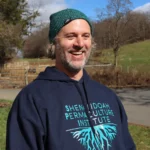By Ryan Blosser and Danny Lee
My name is Ryan Blosser, and I currently work as a farm educator in Virginia. This isn’t necessarily the job I imagined for myself back when I was young, but now I can’t imagine doing anything else.
My career throughout the last few decades can best be described as a textured one. I’ve spent time as a child and family therapist, an education non-profit leader, an SEL coach, an organic market farmer, and even a classroom teacher. Never one to stand still for very long, I’ve tended to move frequently between new challenges and interesting projects.
I like change and I like novelty, but I think what I’ve truly been seeking is the sweet spot; that perfect moment when vocation and avocation blend together to optimize the biggest impact on the local community. And, at last, I think I’ve finally found it, on the Waynesboro Education Farm.
Ryan Blosser, MA, EdS, is a farmer, educator, permaculture designer, writer, and former child and family therapist. He is co-founder of the Shenandoah Permaculture Institute and owner/operator of Dancing Star Farm. The intersection of his twin passions for growing food and helping people fuels his unique perspectives on education and building community health and resilience through permaculture design.
Danny Lee is a 26-year veteran of the public education classroom, having taught grades 1, 2, 3, and 5 before transitioning to gifted education, where he serves two elementary schools. Danny is a believer that all kids need exposure to higher order thinking, and he has an interest in developing executive function skills in young learners. He is also an avid theater nerd who has found a passion for directing community productions.



